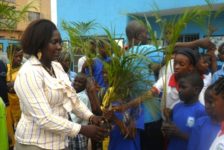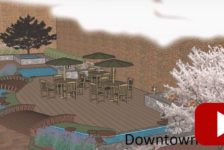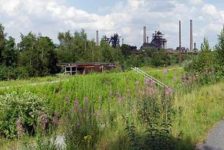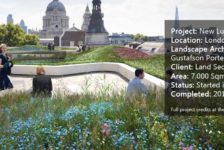5-October-2015 The Latest News in Landscape Architecture 2015 is sponsored by ZinCo – Life on Green Roofs – Ecological and Economical Green Roofs, worldwide. In this week’s Latest News in Landscape Architecture we highlight new trends reshaping cities, feature a proposal for a major plaza in Iran, and take a closer look at the need for park space in major cities. Did you know that Vienna (51%), Singapore (47%), and Sydney (46%) boast the highest percentages of public green space in the world according to a 2013 report? 5 Stories In The News This Week:
- Which Comes First, the Park or the People?
- 8 Cities That Show You What the Future Will Look Like
- Root Microbiome Engineering Improves Plant Growth
- A Finnish Landscape Architect Tries to Connect the Broken Pieces of Boston’s Emerald Necklace
- Farahmand Collaborative Teams’ Qibla Plaza Proposal for Mashhad
(Click the headline for the full story)
Latest News in Landscape Architecture
From the “California Dry” style developed by landscape architects in Los Angeles, which essentially replaces imported plants and water-dependent turf with native and drought-tolerant species to “library parks”developed in Medellín, Colombia by Alejandro Echeverri (Former Director of Urban Projects) and the bicycle infrastructure engineering marvel known as The Hovenring based in Eindhoven, Netherlands—these are just a couple projects reshaping cities. Related Article: What Makes a Biophilic City? WATCH: How Amsterdam is Building the City of the Future (Future Cities by Skift and MasterCard)
- Root Microbiome Engineering Improves Plant Growth: EurekAlert! Science News
Two biologists showcased how to engineer plant soil microbiome to improve plant growth regardless of the plant’s genetics. First published as a review paper in Trends in Microbiology, Ulrich Mueller of the University of Texas at Austin and Joel Sachs from the University of California, Riverside have successfully witnessed microbiome engineering with Arabidopsis (a close relative of cabbage and broccoli). “For agricultural applications, I would start with artificial selection of root microbiomes in a greenhouse environment, using cash crops such as lettuce, cucumber, or tomatoes, learn from these greenhouse experiments, then gauge whether any of these principles can be applied to outdoor agriculture and horticulture,” said Mueller. Related Article: 9 Awesome Ways to Use Plants WATCH: Engineering Microbiomes / Trends in Microbiology October 2015 (Vol. 23, Issue 10)
- Which Comes First, the Park or the People?: Urban Land Magazine
As urbanization continues across the globe, cities are searching for creative ways to transform abandoned and underserved spaces into parks. Trust for Public Land (TPL) has demonstrated that many U.S. cities need many more parks based on a series of studies. Currently, only a handful of cities in the United States (e.g.New York City, Boston, San Francisco, Washington, DC) offer park space within a half-mile or ten minute walk. While, it’s been well documented that investment in transit-oriented development can successfully spur a mixed-use palette of housing, commercial space, and retail, the same concept can be said for park-oriented development. “In cities, density not only matters, it’s crucial,” says Mahlon “Sandy” Apgar IV, a real estate counselor and author. “Parks are one of the key features that can bring it about.” Related Article: Top 10 World Class Landscape Architecture Projects of 2014
- A Finnish Landscape Architect Tries to Connect the Broken Pieces of Boston’s Emerald Necklace: Public Radio International
Finnish landscape architect Maria Jaakkola (Head of the Environmental Office in Helsinki’s City Planning Department) has always had a fascination with the Emerald Necklace and has viewed this series of interconnected parks as “an iconic greenway example”. However, during her yearlong fellowship at Harvard’s Graduate School of Design she had the opportunity to further explore the greenway with much dismay. “It’s very unkempt,” Jakkola says. “There’s been some attempt to make a place for people but there are no benches. There is a light but it’s broken. No one is ever here. I’ve been here several times and I’ve never seen anyone.” WATCH: (Dis)connected – A project by Maria Jaakkola, Landscape Architect and Visual Artist
Situated in Mashhad, Iran and home to over 25 million religious visitors each year, the city has outgrown its existing infrastructure. Subsequently, an open design competition was held, which invited designers, architects, and engineers to develop proposals for the “Qibla Plaza”. The Farahmand Collaborative, which consists of Erfan Farahmand, Elmira Jafari, Abbas Sarrami, and Meisam Amirsadat plus additional consultants was awarded first place in the initial stage of the competition. Their design features six levels of urban subterranean space and includes public transport stations, bathrooms and other amenities, access to the religious complex, commercial and cultural gathering spots, and ample utility space. Check out the gorgeous diagrams! Related Article: Top 10 Public Squares of the World WATCH: Qibla Plaza Area Plans for mashhad
–
Latest News in Landscape Architecture 2015
News report by Brett Lezon
The Latest News in Landscape Architecture was brought to you by Landscape Architects Network and our sponsors ZinCo – Life on Green Roofs – Ecological and Economical Green Roofs, worldwide.
For all of the hottest news continue to follow us on Facebook and Twitter. Have news to share? Send to office@landarchs.com
Published in Blog






